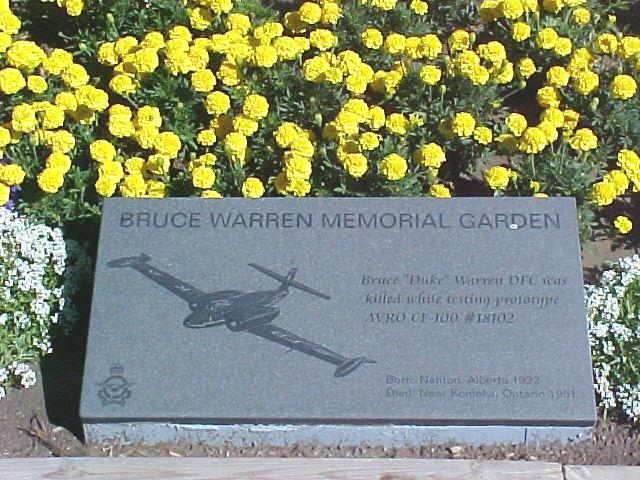 Museum
Museum  |
Bomber Command
|
Aircrew Chronicles
|
Aircrew Losses
|
Nose Art
|
BCATP
|
Lancaster
|
Media
|
Bomber Command
|
Aircrew Chronicles
|
Aircrew Losses
|
Nose Art
|
BCATP
|
Lancaster
|
Media
 Museum
Museum  |
Bomber Command
|
Aircrew Chronicles
|
Aircrew Losses
|
Nose Art
|
BCATP
|
Lancaster
|
Media
|
Bomber Command
|
Aircrew Chronicles
|
Aircrew Losses
|
Nose Art
|
BCATP
|
Lancaster
|
Media
Bomber Command Museum Archived Newsletters
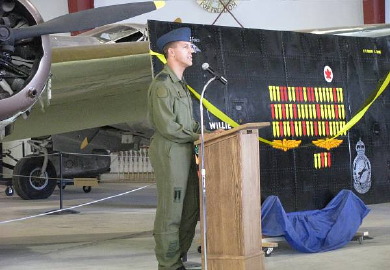
|
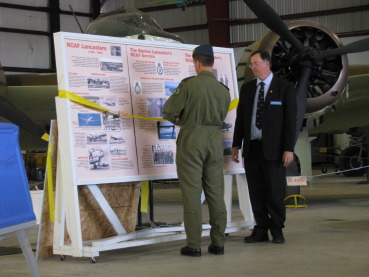
|
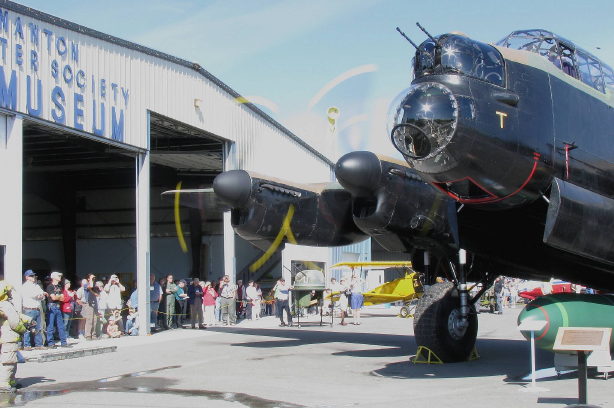
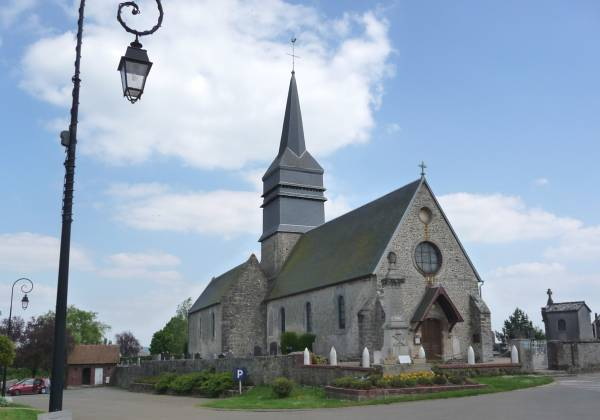
|
As part of our celebration of Canada's Centennial of Flight, the museum's special event next summer will focus on the sixty-fifth anniversary of Ian Bazalgette's Victoria Cross Flight. As most of our members are aware, our Lancaster was dedicated to S/L Bazalgette in 1990. Although our museum building had yet to be built and the aircraft remained outside, it was a very significant step in the development of the museum as we forever tied Alberta's only WW II V.C. recipient with the centrepiece of what would become the museum that honours the Canadian airmen who flew with Bomber Command. "Remembering Baz" will rejuvenate this relationship between our museum and S/L Bazalgette. We encourage our members to mark the date on their calendars and join us in Nanton. During May, museum director Dave Birrell visited Downham Market in England where Baz was based and the small French village of Senantes which Baz overflew prior to landing the aircraft. It subsequently exploded killing all three that were still aboard. S/L Bazalgette is buried in the town's churchyard. Dave visited the crash site and spoke with Simèon Desloges who, as a nine year old boy, watched Baz's flaming Lancaster fly over his farm and land in a nearby field. The museum is working on some projects which hopefully will come to fruition at our "Remembering Baz" event next summer. Simèon Desloges, of Senantes, France, holds a piece of the original Bazalgette Lancaster, F-2T, which he recovered from the crash site near his farm. |
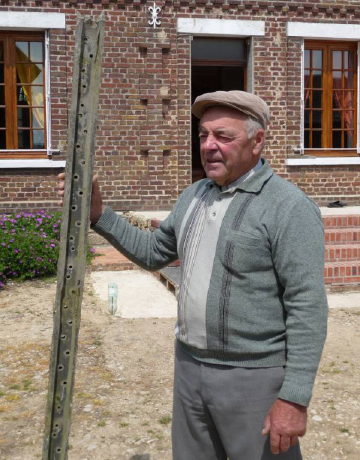
|
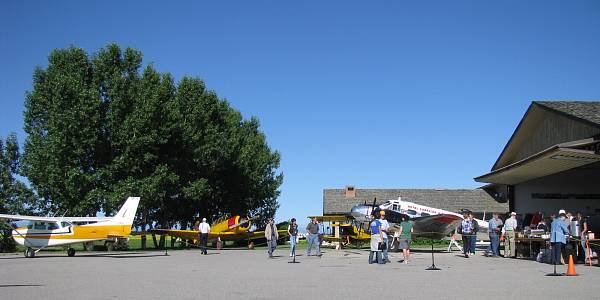
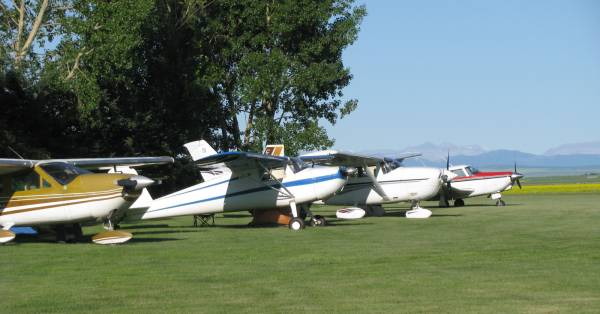
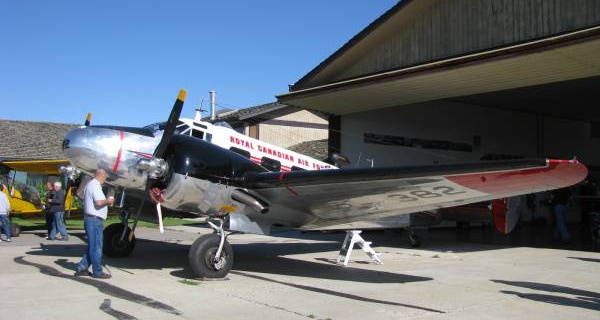
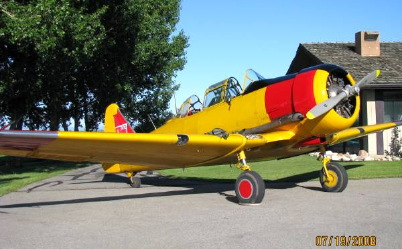 Former Harry Whereatt Harvard. |
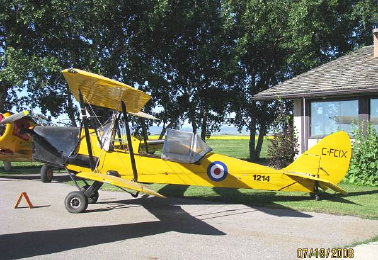 Gordon Jones' Tiger Moth. |
|
As most of our members are aware, Phase I of our museum's expansion was completed in 2007 when 14,400 square feet were added to the north of our main hangar. Phase II was completed this year with the installation of heating and electrical systems and the interior finishing of our shops and "The Joe English Room." Phase III will see the installation of a sprinkler system for the entire building (a requirement under current building codes) and the construction of a large mezzanine for displays and aircraft viewing. Following this our previous shop area will be removed to connect the expansion area and the original hangar area. As well, our "small artifact" area will be enlarged and additional washroom facilities be made available. The cost of this final phase of our expansion is estimated to be $300,000 and we are actively seeking funding to complete the project. If you are able to assist or have ideas as to how the museum might access corporate or government support please let us know. |
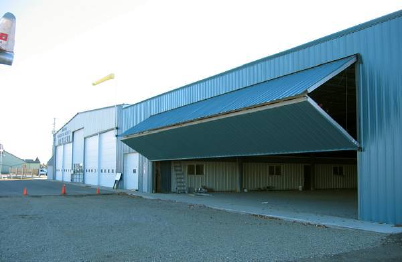
|
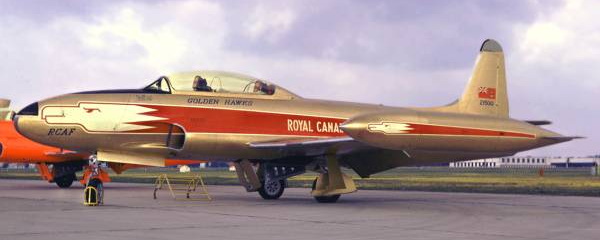
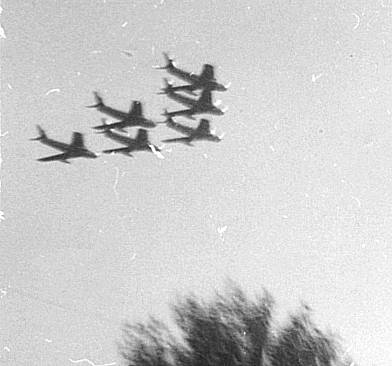 The "Golden Hawks" fly over Nanton back in the '60s when Jack Allan was their C.O. |
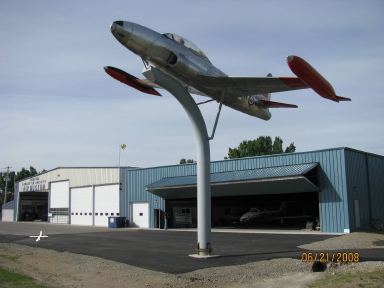 T-33 dedicated to Nanton's Jack Allan. NLS volunteers and a rented crane, moved this gate guardian last spring. The whole tarmac area is now clear for parking aircraft outside. The white X marks original psition of this gate guardian. |
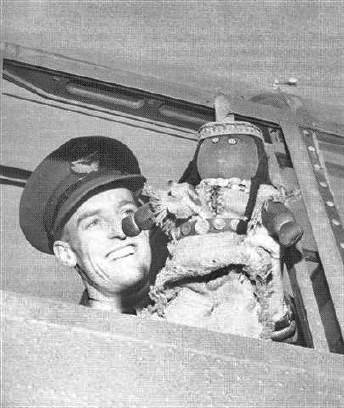 No. 431's wartime C/O, W/C Eric Mitchell, holds the original "Minnie Simcoe" doll. |
No. 431 "Iroquois" Squadron was adopted by the City of Simcoe, Ontario, and its citizens supported the airmen by sending items such as chocolate, candy, gum, toothbrushes, and knitted garments to the airmen. An unknown Simcoe resident made an Indian princess doll which made the trip overseas and eventually became the squadron's mascot. "Minnie Simcoe" flew at least eighteen operations aboard the No. 431 Lancasters. When the squadron c/o was posted elsewhere, "Minnie" was presented to him and her current whereabouts are not known. However one of our members, Marg Liessens, made contact with a resident of Simcoe, Myrle Smith, who made a replica of the doll and it is now on display at the museum. As the original "Minnie" had flown with No. 431's wartime c/o, W/C Eric Mitchell, Marg and other members of our museum felt it fitting that the replica "Minnie" should have a flight with the current c/o of No. 431 Squadron which is now the Snowbirds. So this summer at the Rocky Mountain House Air Show, as Major Rob Mitchell (yes, both COs are named Mitchell) was buckling on his parachute, Marg watched as the little doll was tucked into Snowbird #1. A few minutes later, "Minnie" was airborne and Marg found it difficult to take her eyes off Snowbird #1 knowing that a very special passenger was aboard. It was a remarkable way to connect the wartime airmen of the squadron to today's pilots who fly a very different role with No. 431. Our thanks to Capt. Jennifer Jones and Major Mitchell of the Snowbirds for their cooperation. |
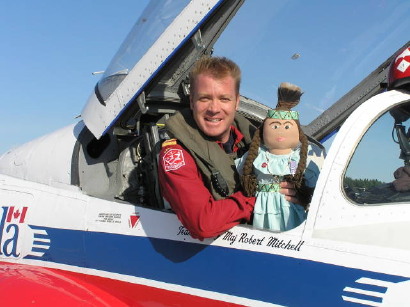 Major Rob Mitchell with the replica Minnie Simcoe doll sitting in SnowBird #1 at the 2008 Rocky Mountain, Alberta, air show. |
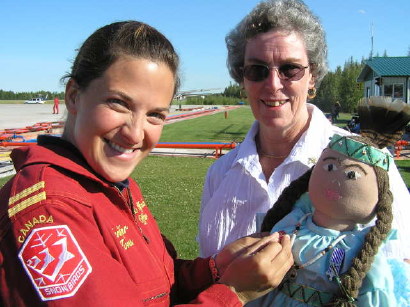 Seen here at the Rocky Mountain air show Capt. Jennifer Jones, of the SnowBirds team, is pinning a Snowbird pin onto the "Minnie Simcoe" doll (held by Marg Liessens) before her flight as the Squadron mascot. |
|
Our volunteers enjoyed taking our museum's "Travelling Display" to four events this summer. The Cranbrook Air Show featured the Snowbirds and we visited with many people from the west Kootenay Valley. We were also pleased to be part of the North American Tournament at the huge Spruce Meadows complex south of Calgary as part of their "Salute" to our armed forces. Our Lancaster cockpit section was a major attraction for the huge number of visitors to this remarkable venue over a four-day period. We joined our friends at the Reynolds Alberta Museum when they hosted an excellent and very well attended two-day air show. The Snowbirds were perfect and there were a number of other spectacular flying displays. Maurice Galli of Rocky Mountain House has been one of our special volunteers over the years and through him we have enjoyed a unique relationship with the bi-annual Rocky Air Show. Like previous shows, this was the "Best Ever" and was attended by thirteen of our museum's volunteers. With the celebration of Canada's "Centennial of Flight" next summer, we'll be "On the Road Again." Watch our website for the schedule and visit our display if you're able to attend any of the events. |
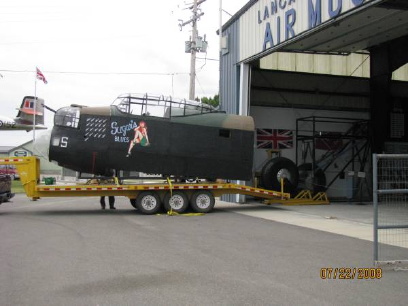 to the Spruce Meadows, North American Tournament. |
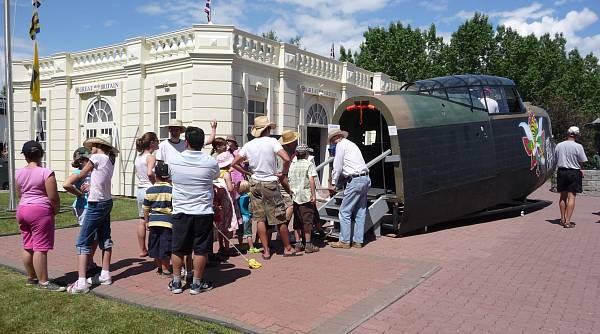
During our salute to the "Americans in the RCAF" during the summer of 2007, we paid tribute to Joe McCarthy who served with No. 617 Squadron and flew on the Dams Raid. His son, Joe McCarthy Jr., was present and unveiled a large piece of artwork that had been painted on a Lancaster wing panel by Clarence Simonsen. The images were replicas of nose art that had been painted on Joe's No. 617 Squadron Lancasters. Each one featured a panda bear. Clarence's artwork, together with the related information and wartime photos were then placed on www.lancastermuseum.ca. Last summer, we were contacted by Dorothy Bailey who lives in Yorkshire, although her father was a Canadian. She wrote, "I've just found your website, having done a search for "Q for Queenie" and found the article on Joe McCarthy's nose art. My father, William (Bill) Radcliffe, was Joe McCarthy's Flight Engineer on both No. 97 Squadron and No. 617 Squadron. I have a small panda bear about 5" high which my father had as a mascot, tucked into his boot during every flight. I have always understood that it was the mascot for the whole crew. Having seen your article I now wonder if the panda was given to my father because of the nose art or whether the panda actually gave rise to the nose art. "All the wear on him must have happened whilst he was at war as he was never played with by me or my siblings. His right ear is quite worn down and his nose is threadbare!" Dorothy has sent us an excellent photo of one of the nose art images as well as a photo of the panda that accompanied Joe McCarthy's crew on all their operations, including the Dams Raid. Visit our website, www.lancastermuseum.ca for the complete story. |
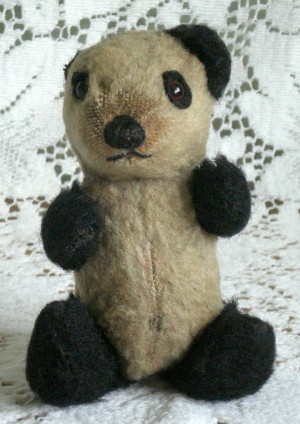 |
The museum has honoured one of our founding directors by naming our new "multi-purpose" room in his honour. The reasons for choosing Joe English's name for this room are too numerous to list here but include his service as a wartime Lancaster pilot and as a museum director and volunteer. The only problem with "The Joe English Room" so far is that it was much too small to accommodate all of Joe's family and friends at its official opening. 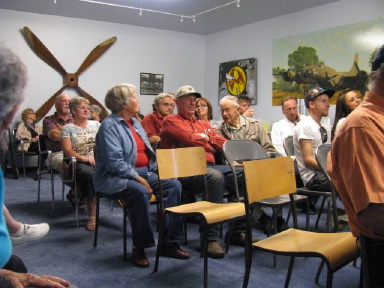 Some of the crowd attending the dedication. The room is a significant addition to the museum. Featuring a variety of aviation art, the space is used on a daily basis as a theatre for our visitors. It is also used by school classes and other groups, for special presentations and social functions. |
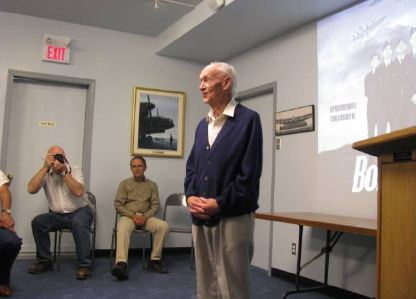 Joe English speaking at the dedication. 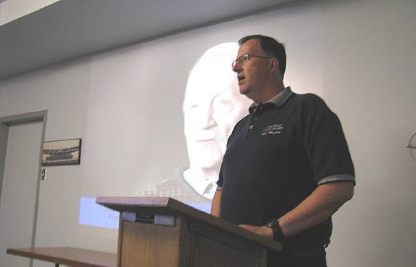 NLS President Rob Pedersen speaks at the official opening of the Joe English room. Look close and you can see Joe's image from the movie "Bomber Boys," in which he starred, projected on the wall. |
Joe English and Pieter Uithuisje continue making progress building the Falco. The fuselage is now stored temporarily in the museum shop while the wing structure is being assembled in Pieter's small shop connected to his home. We understand that they hope to have the wing skeleton (spars, ribs, etc) constructed and assembled before the end of the year. The Falco fuselage skeletn is stored temporarily in the NLS wood working shop. |
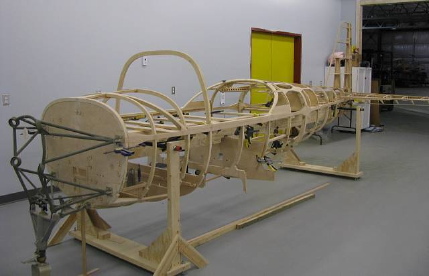
|
The following photos should give the reader some idea as to the progress made in completing the new space in the new addition to the original museum building. Several volunteers have been involved in moving, sorting, and placing the items on the new mezzanine storage area. Volunteer Rick Featherstone's leadership, his donation of the shelving, plus a special frame for hanging uniforms, etc., and his continuing efforts have really contributed to making this happen. Thanks Rick The engine/metal working shop shapes up. ==> |
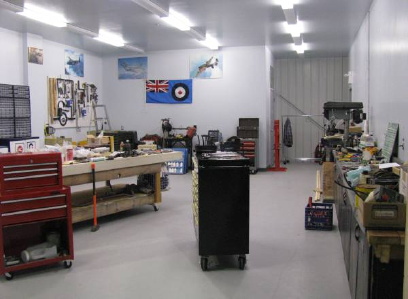
|
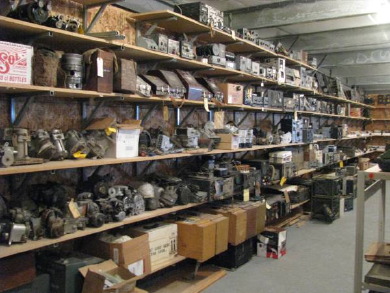 Aircraft parts in storage on the mezzanine. |
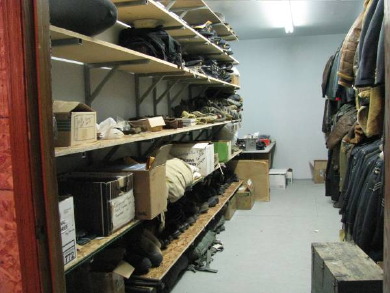 The new uniform room on the mezzanine. |
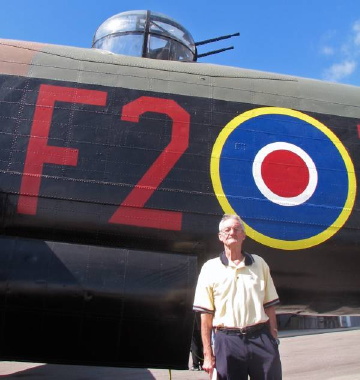
|
There are many stories of young men (many still boys really) who lied about their ages to gain entry into the air force. Last August Frank Barber of London, Ontario, visited the museum and told us that his father was killed with Bomber Command while twice the age of his fellow aircrew. Born in 1901, Joseph Barber was initially refused admission to the military partly because of his trade as a bricklayer but also because of his age. He volunteered numerous times but to no avail. Finally one day, in frustration, he took out his birth certificate and, as his son Frank remembers, folded it repeatedly, back and forth, so that eventually the date of birth could no longer be read. He then volunteered again and was accepted into the Royal Air Force. After training as an air gunner, he flew in Lancasters and Halifaxes. Sgt. Barber had completed seventeen operations when his aircraft failed to return from a raid on Duisburg on the night of 21/22 May, 1944. Frank Barber stands beside Nanton's Lancaster bomber after telling the story of his father Joseph, as related above. |
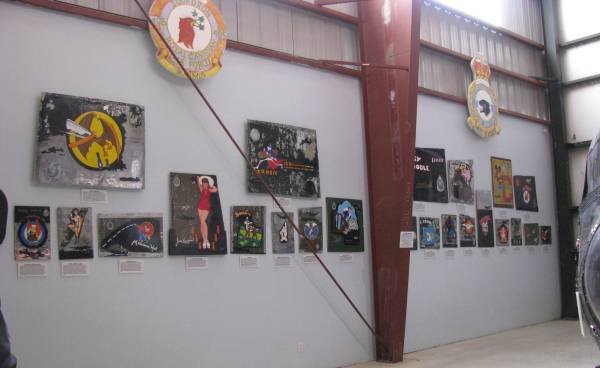
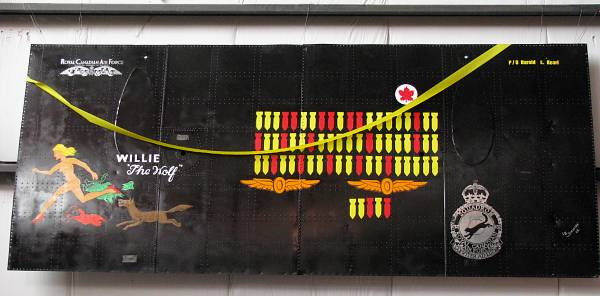
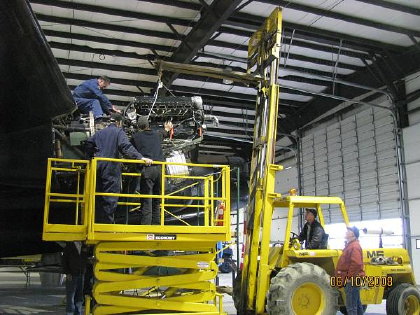
|
After a longer than expected stay in the shop, #4 engine was hung mid-year 2008 into its engine bearers. After much hook-up work involving the cooling system (we had installed a British header tank which unknown to us was slightly different from the Canadian Mk X tank), we had to then install the proper one which enabled the thermostat to fit. Some oil lines had to be cannibalized from #2 engine and a feed line improvised due to lack of original large diameter copper oil lines. An up-to-date temperature indicating system was installed to do away with the unobtainable temp probes used originally. Even the overhauled prop installation had a minor glitch involving an oil seal. Eventually we were ready for the shake-down runs which yielded some more glitches that were overcome by the perspiring and willing Lanc engine crew.
Seen here on June 10, the newly overhauled starboard outer Merlin engine is being reinstalled on Lancaster FM159. |
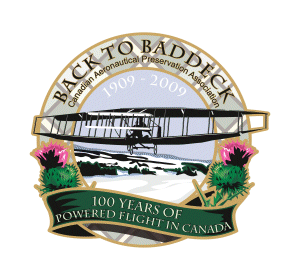
|
Our museum will be participating in a commemorative flight that will begin in Baddeck, Nova Scotia (the location of the first powered flight in Canada in 1909), travel to Newfoundland, and then across the Canadian Arctic (with considerable help by an air force Aurora). Following the Aurora's arrival at the Comox Air Museum, a series of some 33 legs will be flown "Back to Baddeck" by a variety of vintage aircraft arranged by aviation museums. This project is being co-ordinated by CAPA (the Canadian Aeronautical Preservation Association), the organization that speaks for the aviation museums of Canada. Our museum is scheduled to participate by welcoming the arrival of an aircraft from The Canadian Museum of Flight on May 30 as part of our "Planes, Trains, and Elevators" event. Our participation leg will be from Nanton to Springbank Airport west of Calgary. We hope to have Gordon Jones fly this leg in his Tiger Moth to where he will be met by members of the Avro Museum who will carry on to the Aero Space Museum at Calgary. |
On Sunday, October 26, seven private aircraft from the area around Calgary took part in an old fashioned type fly-in to Nanton. They landed in a stubble field adjacent to the town and walked the 1/2 mile into town to visit the air museum. This fly-in was organized by Paul Botting of Calgary who flies a restored Piper Vagabond. Some of the other aircraft in the group were an Aeronca Champ, Piper Super Cub, Team Minimax, Quad City Challenger, and a Macair Merlin. |
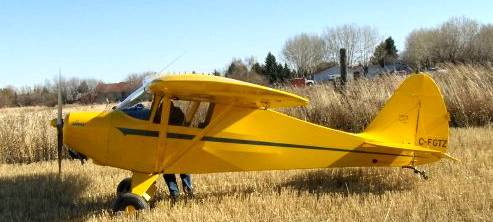
|
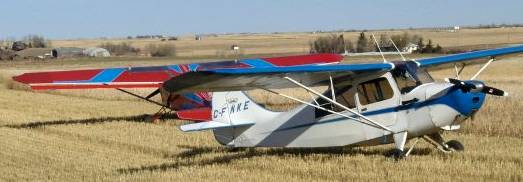
|
After spending part of the morning in the museum they lunched at one of the local eating establishments and then returned to their aircraft for the flight home. These flyers suggested a grass strip near town would encourage more such visits to the benefit of flyers and the community. |
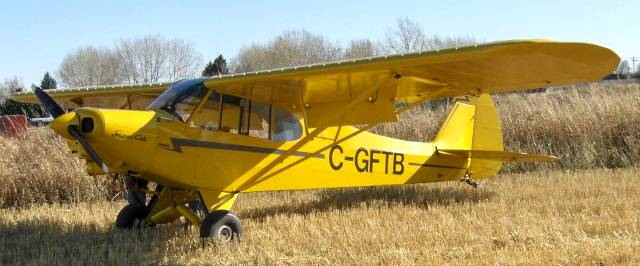
Presently in a jig and under restoration is the wing centre section. This assembly has been waiting for a sub-spar to be made by a firm in Calgary. It is hoped that this component will be on hand shortly and work will resume. Also, Bob Long, who had been working on this project, is back volunteering in the shop after being unavailable the past year. He is gung-ho to get started on the Yale again. As mentioned in previous newsletter, the restored rear fuselage is now in Marcus Stephenson's new shop at Springbank where he will be painting it. Marcus also has a Yale project which is slowly evolving. Also the rudder and elevators are now in the museum ready to be worked on once the move to the new shops is completed.. We will have some more news on this rebuild in the spring newsletter. |
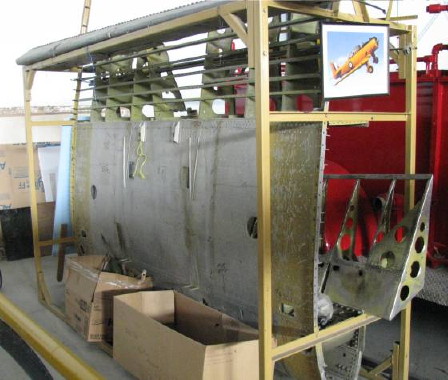 Pictured here is N.A. Yale wing centre section in its rebuilding jig. As we go to print with this newsletter, this unit is about to be moved into the new metal/engine workshop where restoration will continue. |
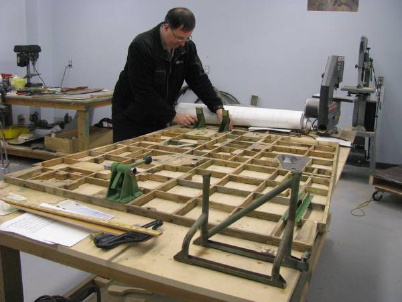 Rob Pedersen checks the positions of the components that will be attached to the Anson cockpit floor after the plywood skin is applied to the substructure. The floor should be completed before year end. |
It seems like it has been a long time coming but progress can finally be seen on old faithful Annie. She has been bare for so long, stripped of her formers and covering, that she seemed more a skeleton than an airplane. Now with the window frames finally completed and installed, the formers, windshield and upper decking have followed. You now look at her and instead of asking, "Is that an airplane?" you know "That is an airplane!" The formers for the cabin have been clamped in place to ensure that everything aligns and fits, just as it should. (see photos of cabin.) Off of the airframe, the cockpit floor is nearing the last of its restoration. The floor is 100% authentic and has retained over 90% of its original materials. To look at its lattice structure one wonders if it could have ever been strong enough to support anyone. (see photo of floor below). Over the winter our Anson restoration crew will finish the cabin by installing the remaining fuselage formers and floors. We have also begun to assemble the spar table that we obtained from the Aerospace Museum of Calgary several years ago. Upon this table we will begin to restore our original wing spars. I would like to thank John Maze, Charles Logie, Alan Palmer and Gary Amundrud for their tireless dedication. Without their efforts Annie would still be a skeleton sitting in the corner somewhere. |
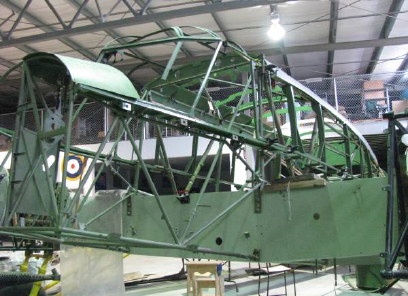
|
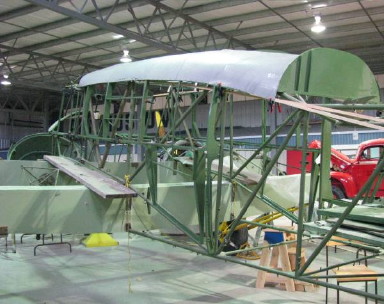
|

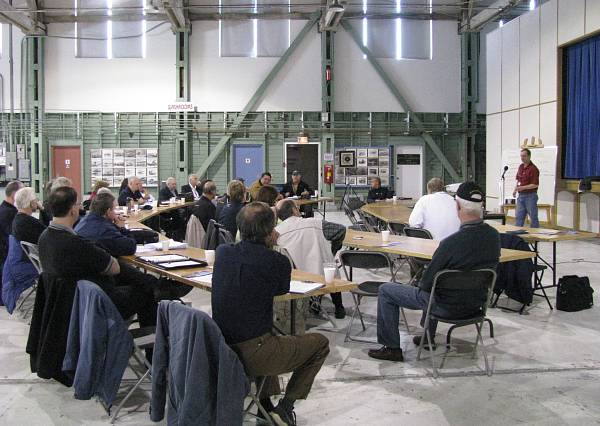
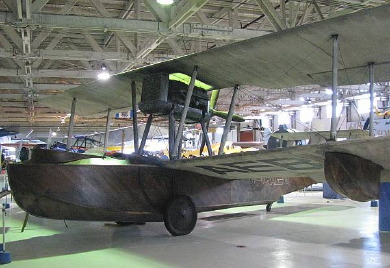 7/8 scale Vickers Viking. |
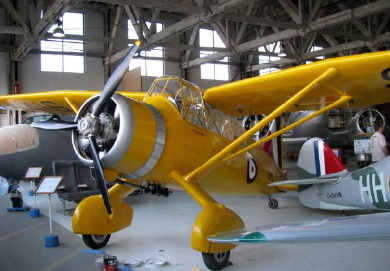 2/3 scale Westland Lysander. |
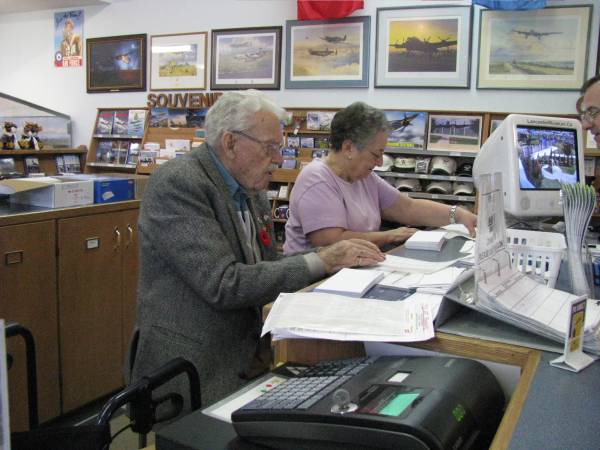
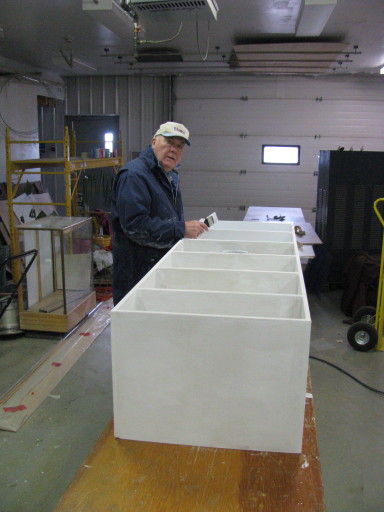
|
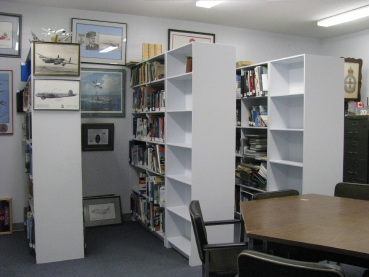 The museum's library collection has been expanding every year until all available shelves were full. Long-time NLS volunteer, Jim Wiersma, who built the original book cases, took on the job of building extensions to the existing cases. The photos: (L) shows jim finishing up the last of the three additions, (R) shows two already in place. Our grateful thanks go out to Jim! |
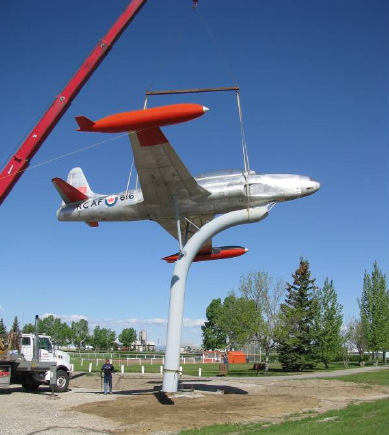
|
The T-33 was moved to new location about 60 feet north to clear access for aircraft being moved out of the new addition hangar on to the museum's tarmac. 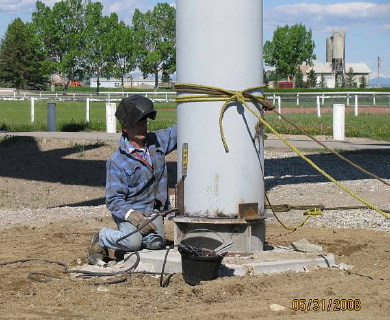 Neil Wilson welds the large pipe that supports the T-33 to its new base. Neil is a longtime friend of the museum who was instrumental in making up the original mountings for both the T-33 and for the museum's CF-100. |
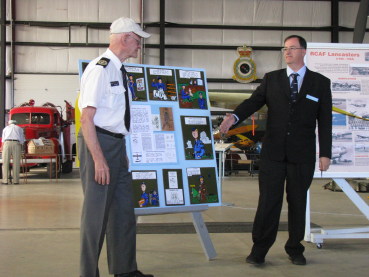 A special display honouring ground crews of WWII and post war is unveiled. |
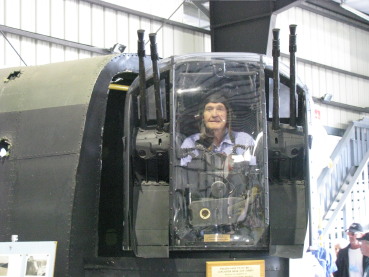 Len Isaacson, from Lethbridge, Alberta, former tail gunner now in his 80s mans the guns in the museum's restored rear turret. |
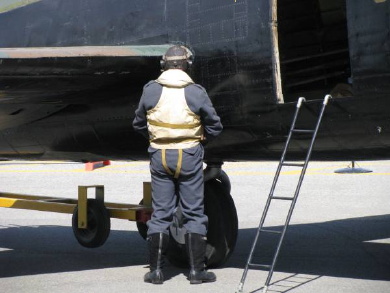 The last "crewman" to board the Lanc waters down the tail tire for luck on the Op. |
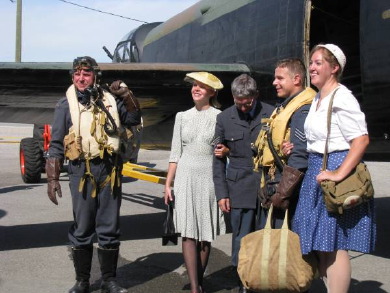 The Re-Enactors who helped make the day dressed as aircrew were accompanied by their ladies, also dressed in period costume. |
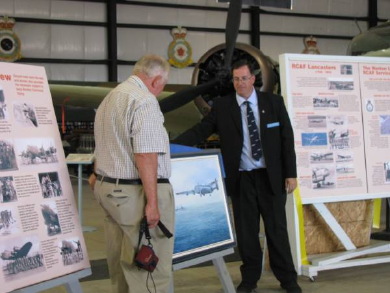 Former Lancaster flight engineer, Duke Dawe, assists Rob Pedersen in unveiling the special "Lancs of the 50s" painting by aviation artist, John Rutherford. |
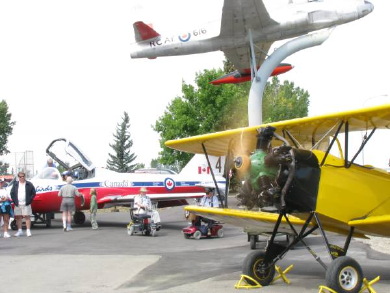 Here the Fleet Fawn's Kinner engine is being run-up. In the background visitors try out the SnowBird Tutor's cockpit. |
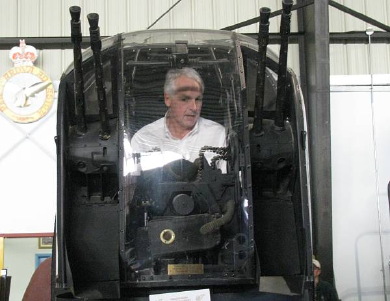
|
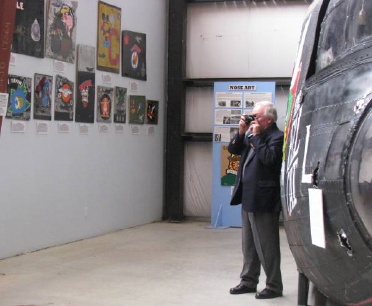
|
